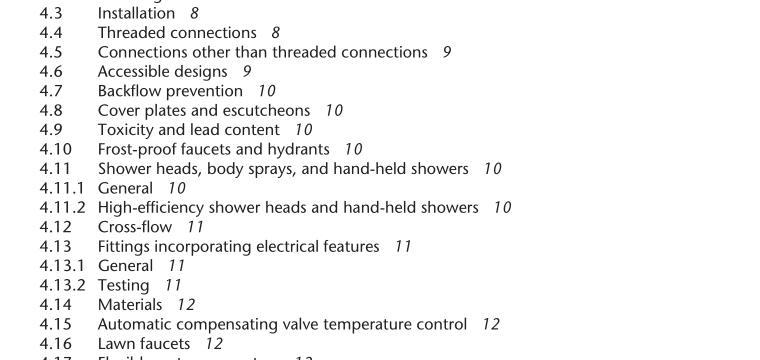ASME A112.18.1:2012 pdf free download
ASME A112.18.1:2012 pdf free download.Plumbing supply fittings
5.9.2.2.2
The critical air gap test for fittings with plain outlets shall be conducted as follows:
(a) Connect the inlet(s) of the specimen to a vacuum source.
(b) Measure the vacuum at the inlet(s) of the specimen.
(c) Provide a means to change the water level in the container, relative to the outlet of the specimen.
(d) Start the test with the water level at the mounting surface level.
(e) With the specimen fully open from the inlet(s) to the place of discharge to the atmosphere, apply a vacuum of 85 kPa (1 2 psi) to the inlet(s).
(f) Hold for 1 min. Back siphonage at this time shall be a cause for rejection.
(g) Slowly bring the water level closer to the discharge outlet until the level at which back siphonage occurs is reached.
(h) At the level specified in Item (g), measure and record the distance between the lowest point of the outlet of the specimen and the water surface.
(i) Return the specimen to atmospheric pressure.
(j) Starting with the water level higher than where back siphonage occurred, apply a vacuum of 85 kPa (1 2 psi) to the inlet(s).
(k) Slowly lower the water level until back siphonage ceases.
(l) Maintain the vacuum for 1 min to ensure that water is not being drawn into the discharge outlet.
(m) At the level specified in Item (k), measure and record the distance between the lowest point of the outlet of the specimen and the water surface.
The greater of the distances determined in Items (h) and (m) shall be the critical air gap of the fitting.
The critical air gap test shall be repeated twice to confirm the critical air gap measurement.
The critical level mark on the fittings (see Clause 5.9.2.1 ) shall be at or below the critical air gap
determined by this test.
ASME A112.18.1:2012 pdf free download
